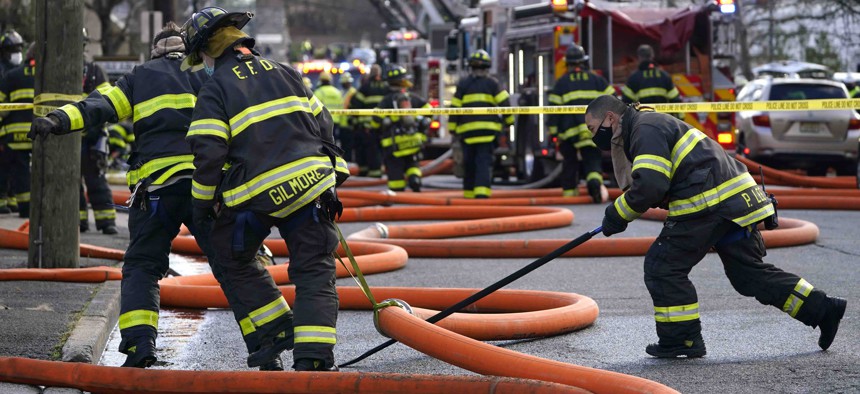Survey: Covid Driving State, Local Workers to Consider Switching Jobs

Firefighters work at the scene of a building fire in Englewood, N.J., on Dec. 2, 2020. Firefighters and other first responders are among the public workers unable to work remotely during the pandemic. AP Photo/Seth Wenig

Connecting state and local government leaders
The newly released findings also show that the proportion of state and local government employees who thought their pay wasn't on par with on-the-job risks was up as well late last year.
There are signs that an increasing share of state and local government employees were souring on their jobs and pay over the course of last year with the coronavirus pandemic wearing on, according to newly released survey findings.
Thirty-one percent, or nearly one-third, of workers responding to a Center for State and Local Government Excellence poll in late October and early November said that working during the Covid-19 pandemic has caused them to consider changing jobs. In a poll the center conducted in May, the figure was only 20%.
There was also a jump in the number of workers who said that the risks they were taking during the coronavirus outbreak were outsized compared to their pay. That figure climbed to 48% from 32%.
SLGE released the fall survey results last week. The October-November findings are based on responses from 1,205 state and local employees. About 1,000 people participated in the May survey.
Rivka Liss-Levinson, senior research manager for SLGE, noted that among employees who do in-person work, the share who described their jobs as at least somewhat risky when it comes to possible exposure to Covid-19 ticked up to around 76% from 70% in May.
The proportion of people who reported that they were required to go into workplaces and didn't have a remote work option roughly doubled between the two polls, rising to 49% from 26%. Meanwhile, the percentage of respondents who reported that the ongoing pandemic had them feeling burned out or fatigued at work swelled to 47% from 27%.
“These health and safety concerns are having an impact on how state and local employees are feeling at work," Liss-Levinson said.
About half of the survey respondents worked in education, 16% in public safety and 13% in health and human services. Each of those parts of state and local government have been on the frontlines of the pandemic response.
Experts point out that—as with other segments of the economy—there's a divide within the public sector. Some employees have been able to go for months now doing their jobs from home, while others, such as firefighters and bus mechanics, can't fulfill their duties remotely and have to go into physical workplaces.
"We call it 'the tale of two employees,'" said Orlando Cruz, senior vice president at ICMA-RC, a group that provides retirement plans and related services to state and local government employees. He described the upswing in the number of workers reporting burnout and fatigue "extremely concerning."
Cruz said ICMA-RC is starting to see an uptick in retirements compared to a year earlier, something he chalked up to a strong stock market keeping retirement account balances stable.
“Right now, they feel like, is a good time to retire,” he said of workers he's heard from. "Many of them are saying, look, 'it's now time for me to get a second job and get into the second phase of my career.'"
A full copy of the SLGE report can be found here.
Bill Lucia is a senior reporter for Route Fifty and is based in Olympia, Washington.

NEXT STORY: Paid Sick Leave and the Prolonged Pandemic





